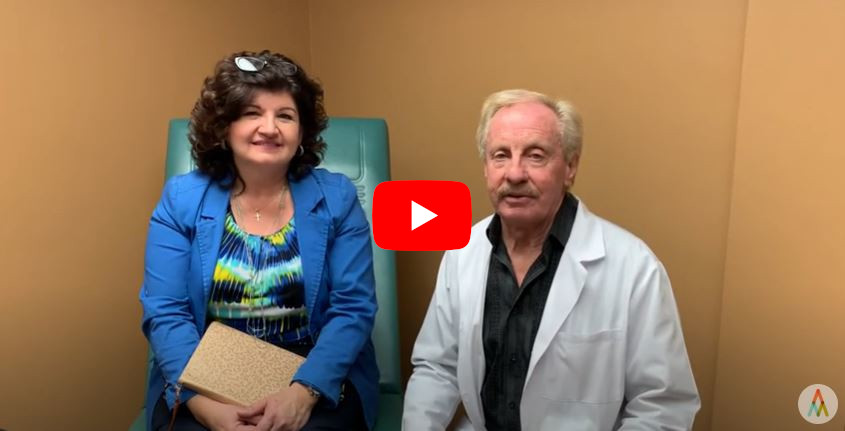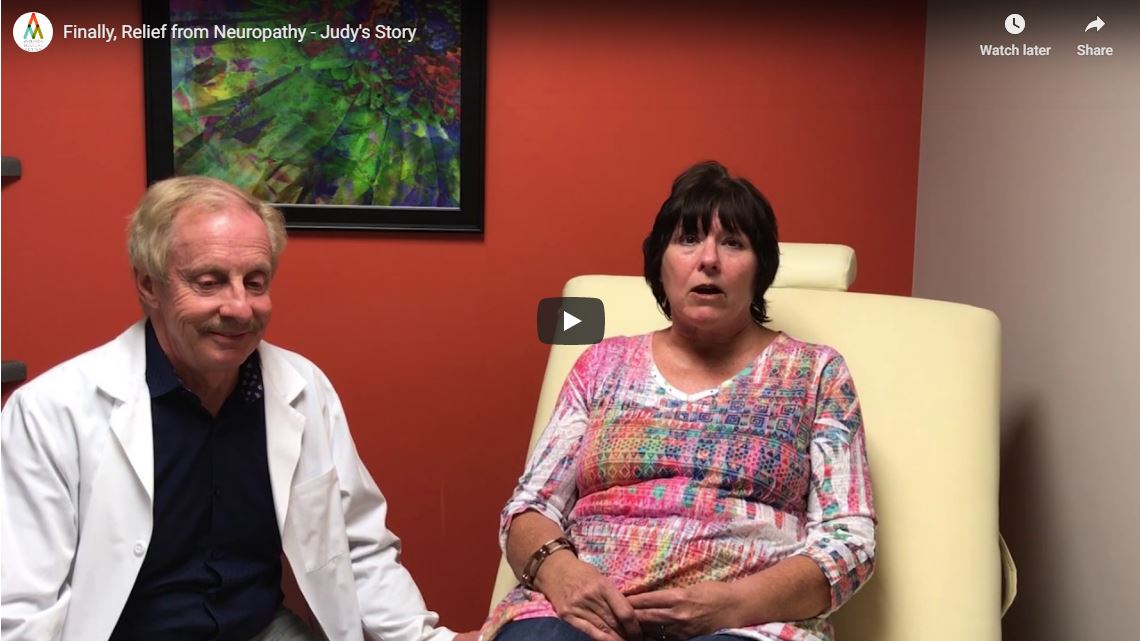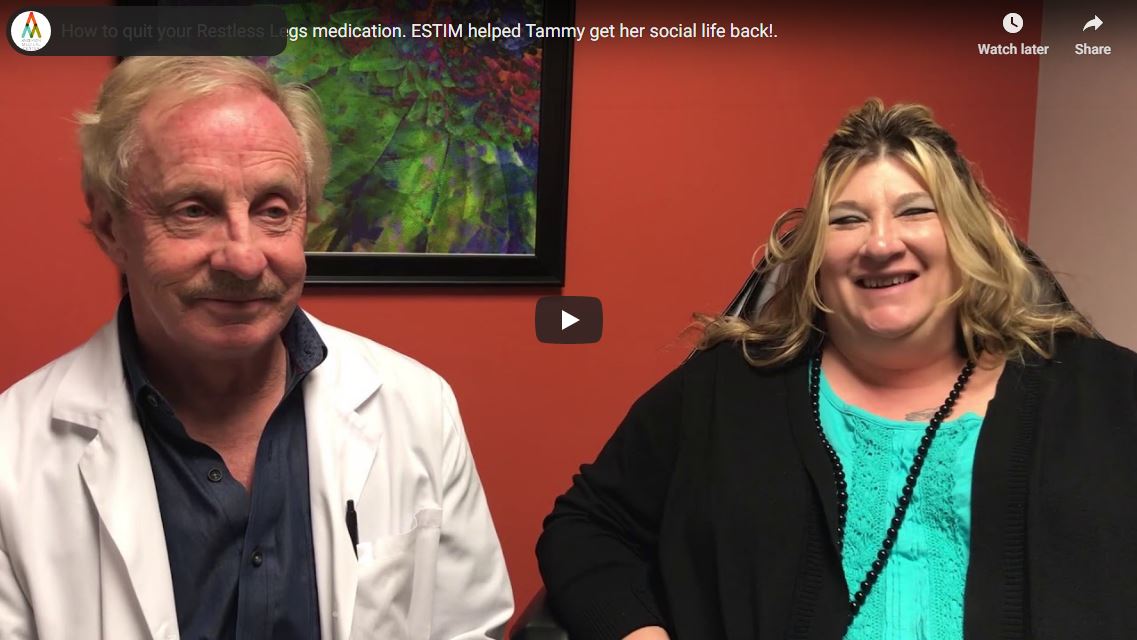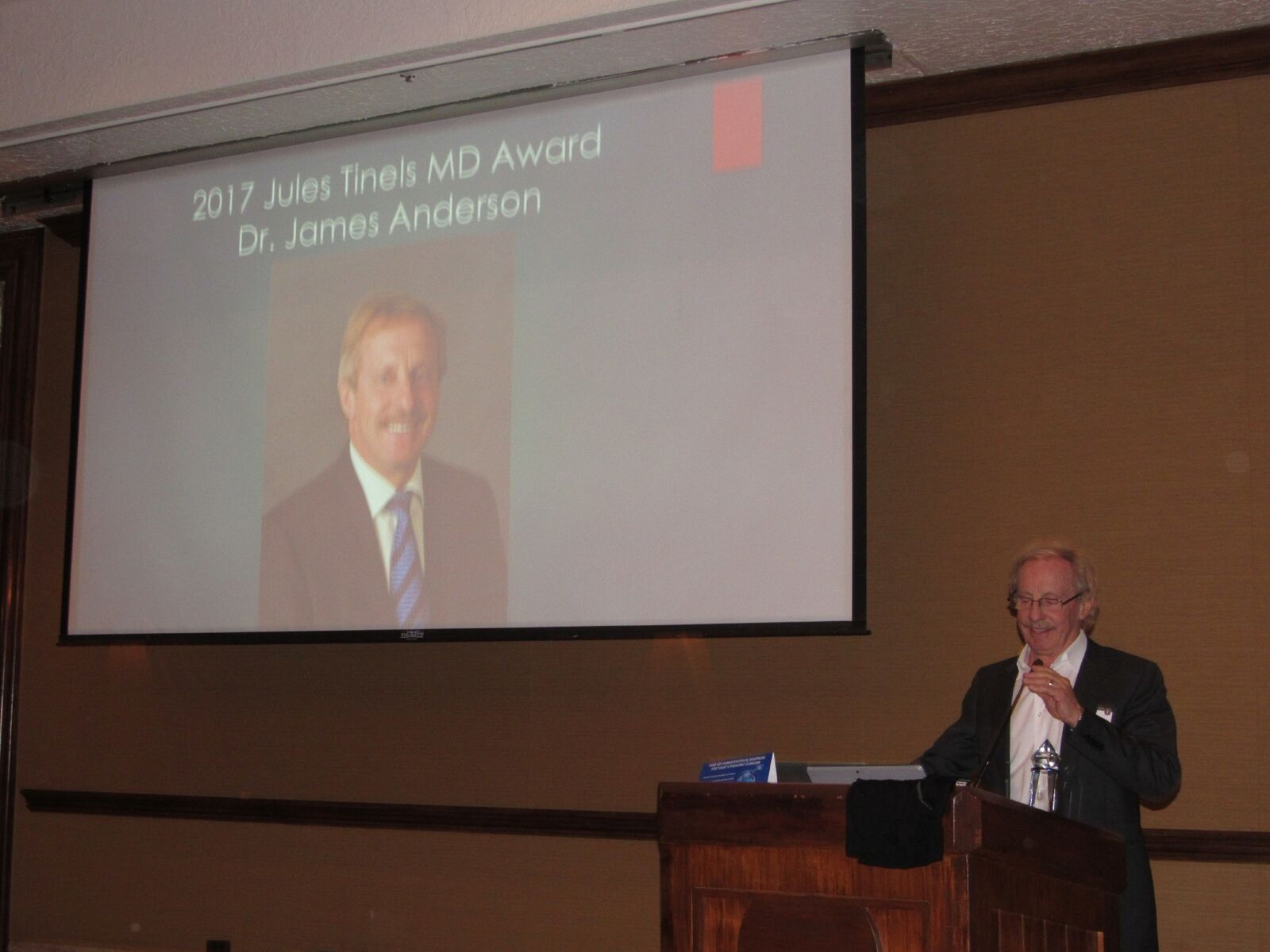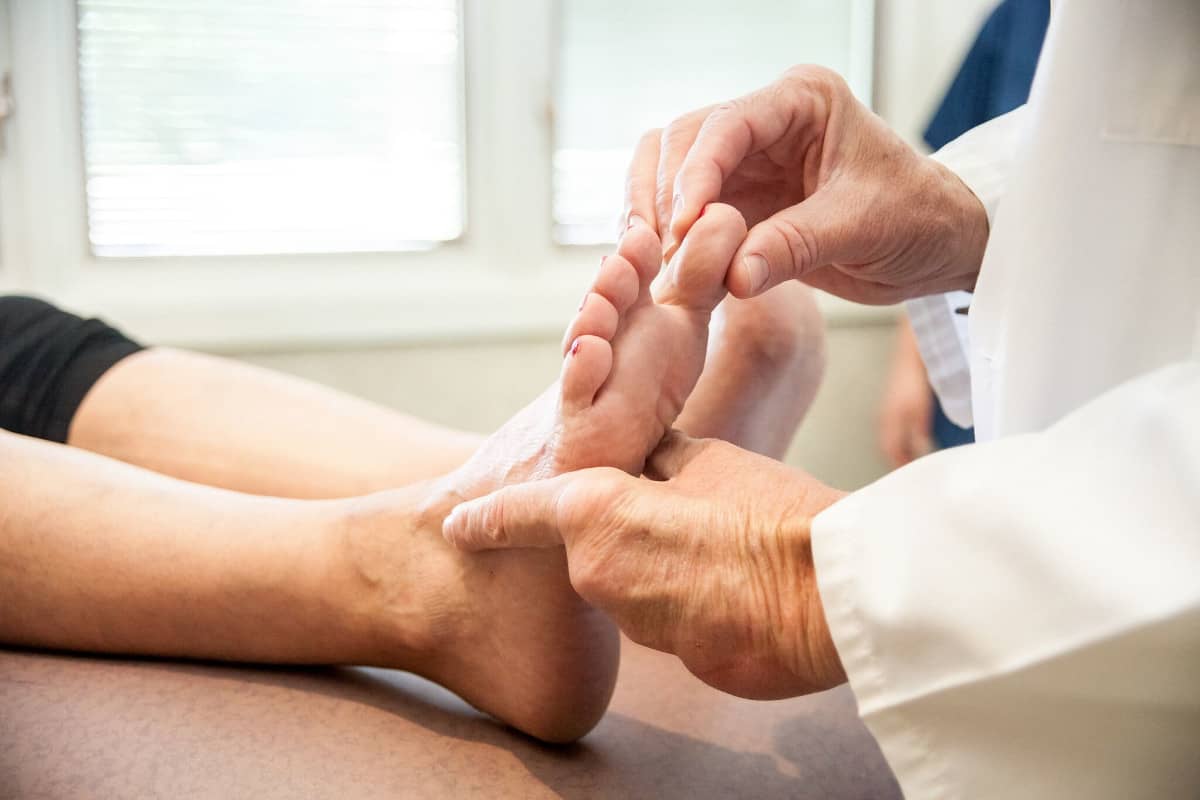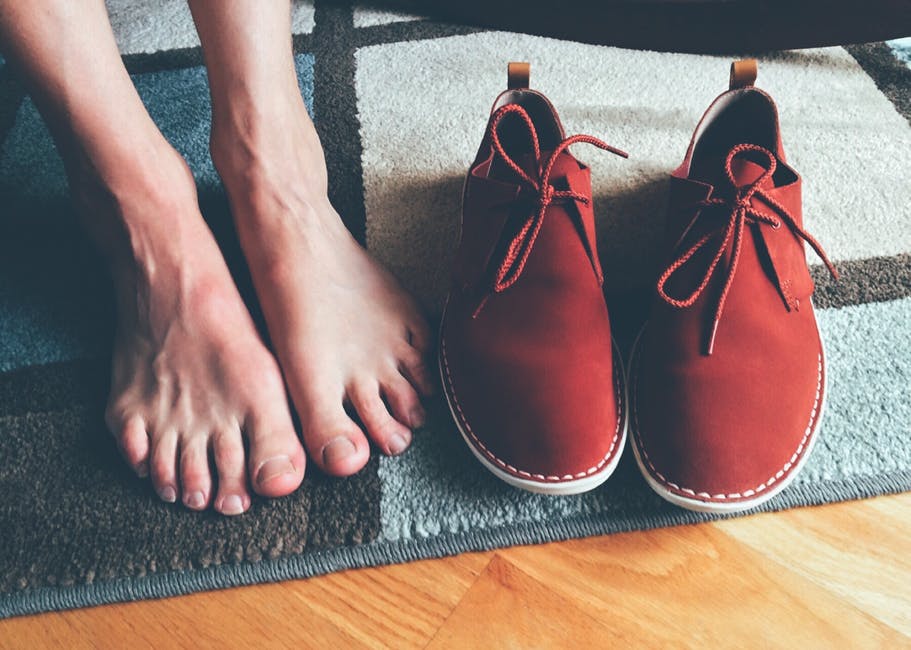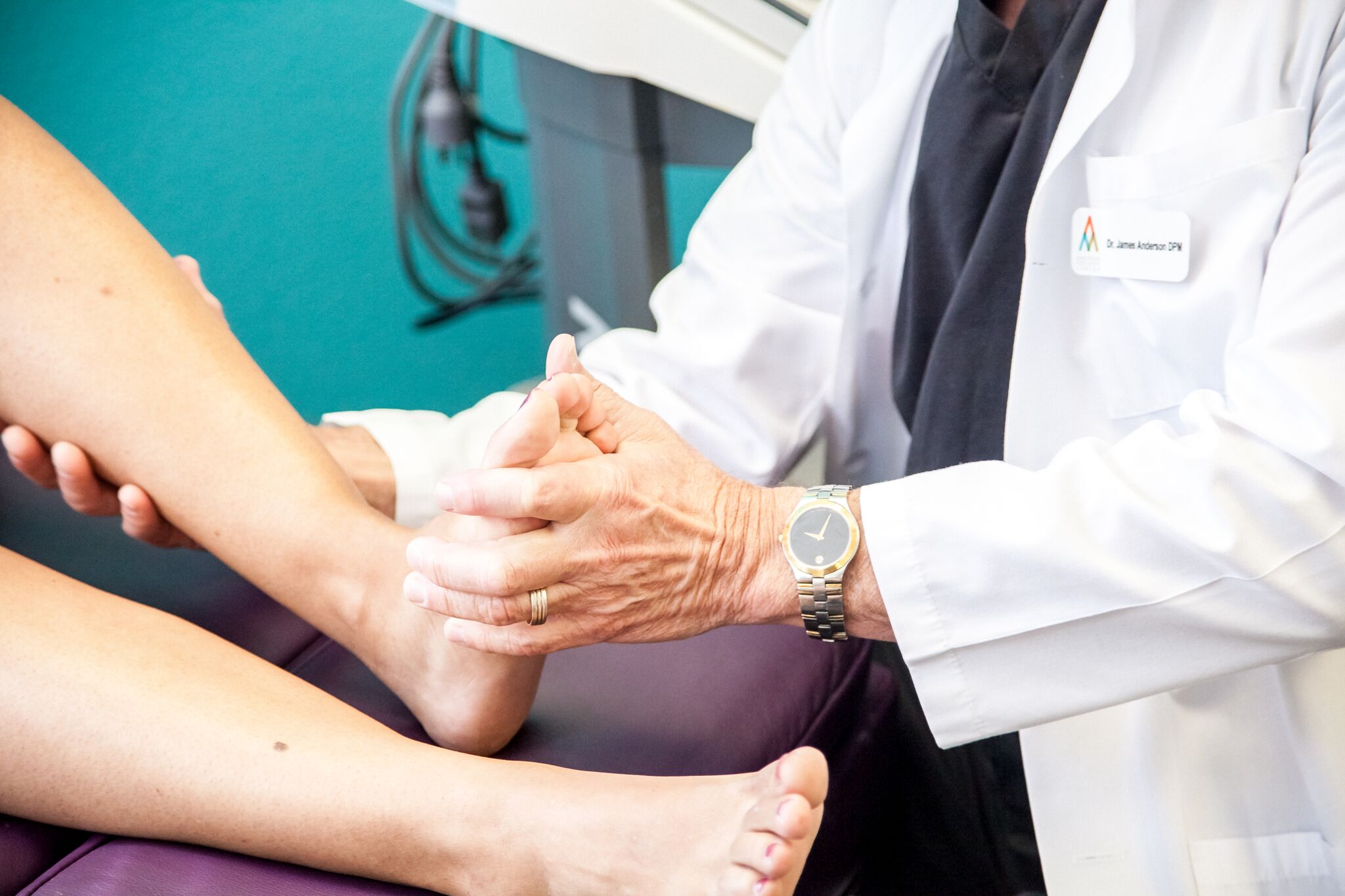Julie was giving up her golf game . Her heel hurt so bad she had to be rescued by a golf cart. We discussed her treatment options with the goal of getting rid of the pain that was ruining her life and avoiding heel surgery. Please watch to learn more. If you’d like more information about how we can help eliminate your heel pain using our advanced technologies please go to our website.
Tag: restless leg doctor
Judy’s Story: Finally, Relief from Neuropathy
Judy Schmidt was at the end of her rope. After more than 20 years of debilitating neuropathy, countless doctors’ appointments, and pain that just wouldn’t let up, she was ready to quit. Finally, she found hope for her neuropathic pain.
Life Before Neuropathy
Judy was a woman with a life. She had run a successful business for more than 30 years, and had no plans to stop. She was a wife and a mother, and had a very active social life. She walked five miles every night, and loved to dance with her husband. Life was good as she experienced no symptoms of peripheral neuropathy.
A Devastating Diagnosis
Suddenly, Judy started to feel burning in her feet. “It just kept getting worse and worse. I went to the doctor, and he said I had neuropathy, or tarsal tunnel syndrome,” Judy says.
“The pain was getting so bad that I couldn’t sleep at night, and I had to go on narcotics. I eventually had to end my career five years earlier than I wanted to because the pain was so severe.”
In a Wheelchair
“I ended up in a wheelchair because I just couldn’t walk any more. I couldn’t drive, I couldn’t go to the store. And, I couldn’t feel my feet anymore, yet I was in excruciating pain 24/7,” Judy says.
She tried everything. Acupuncture, chiropractic care, medication. “They recommended that to reduce the pain we put a pain pump in my stomach to release medicine constantly in my system, and I refused,” says Judy.
She was ready to travel across the country for treatment. “I tried to get into several major hospitals, but they said there was nothing they could do for me.”
Ready to Give Up
“I became a recluse,” Judy recalls, “I didn’t go out with friends anymore, because I couldn’t walk and keep up with the social activities.”
After two nervous breakdowns from being in nonstop pain, and a diminished quality of life, Judy was ready to give up on her nervous system and peripheral nerves. “I’m not that kind of person, I always try to stay very positive and think there’s someone out there who has it worse than me. But, the pain wears you down mentally, and I just got to the point I didn’t want to live anymore.”
A Daughter Steps In
Judy’s daughter Tammy saw that her mom was on a downward spiral. “I felt that I was losing my mom and it was time to do something,” Tammy says. As a nurse who had spent 20+ years in the medical field, Tammy was determined to find a solution.
She went online, did her research, found Dr. Anderson, and made an appointment.
Finally, Joy
Both of Judy’s daughters made the trip from Colorado Springs to Fort Collins to take Judy to see Dr. Anderson, and they finally felt like they had a solution. “They believed in him immediately, and they were dancing in the exam room,” Judy says.
Dr. James Anderson, DPM, says “Judy was suffering from severe neuropathy and nerve pain, and was a great candidate for nerve decompression surgery in both legs.”
Nerve decompression surgery takes less than an hour, patients can walk the next day, and most patients experience little to no pain during recovery.
Judy’s Life Today
Just a few weeks after surgery, Judy came back to see Dr. Anderson, and this time, she was crying tears of joy.
“I moved my toes for the first time in twenty years. I felt the pedal of the car, and carpet under my toes, and I can walk!”
Judy is back to living: walking, driving, grocery shopping, and of course, spending time with her daughters. She is building up her strength again after so many years of not being able to stand and walk.
“To me, this is a miracle,” Judy says, “ I feel like I have my life back, and I am so grateful to Dr. Anderson. My husband and I are going to be dancing again by the end of the year.”
—————————————————————
Don’t wait any longer to see if we can help you make your Neuropathy a thing of the past!
Tammy’s Story: ESTIM for RLS (Restless Leg Syndrome)
A Decade of RLS
Tammy was suffering from RLS (Restless Leg Syndrome), and had been for more than ten years. “I saw at least five different doctors over the years looking for a solution,” Tammy says. “But no one had any answers, and I never found relief.”
“I tried all the medications, and nothing worked,” Tammy says. “I started to feel like it was all in my head.”
Hitting Rock Bottom
Many people who suffer from RLS begin to feel isolated and alone, and this was happening to Tammy. “I’m a very social person, and I couldn’t go to movies or just a simple dinner with my family.”
Tammy was afraid of being out in public and having her RLS symptoms start to kick in. “A lot of people think RLS only happens at night, but for me it was happening all throughout the day too,” Tammy explains. “You never know what’s going to trigger your symptoms, and then you won’t be able to sit down.”
Tammy finally hit rock bottom when she couldn’t do any activities outside her home, and she was only sleeping two hours a night. “I hit the point where I just had to do something,” she said.
ESTIM for RLS
Tammy went to Dr. James Anderson for an appointment, and he recommended ESTIM for RLS.
“ESTIM is a non-surgical treatment that we use to treat RLS and neuropathy,” Dr. Anderson says. “There is scientific, objective evidence that this treatment works to repair the nerves, and Tammy is a great example of what it can do.”
Dr. Anderson also recommended MLS laser treatment, another non-surgical approach that works in conjunction with ESTIM to repair the nerve damage.
How Does it Work?
ESTIM is an electrical stimulation treatment. “We use this to send various pulse waves into the leg, and it can stimulate the nerves to want to repair themselves,” Dr. Anderson explains.
The MLS laser works more on the cellular level. Dr. Anderson says, “The mitochondria is the “energy-creating” part of your cells. The laser works by targeting the mitochondria specifically in the nerve cells to help repair the damaged nerve tissue.”
After 16 ESTIM treatments, Tammy was shocked at the results.
Sleeping All Night Long
“It’s almost unreal,” Tammy says. “I can go to a movie, or dinner, and spend time with my family. I am sleeping all through the night and it’s wonderful!”
After having the treatment, Tammy sat in her recliner and watched six movies in a row, just because she could.
“I didn’t have one episode, and I’m so grateful! I’m now experiencing what it feels like to be normal, and it is amazing.”
————————————————————————————————–
If you or someone you love has been suffering from RLS, please come see us. We have treated hundreds of patients successfully, and we would love to help you get your life back.
Learn about more treatment options for RLS.
To make an appointment, click here.
What Causes Restless Leg Syndrome?
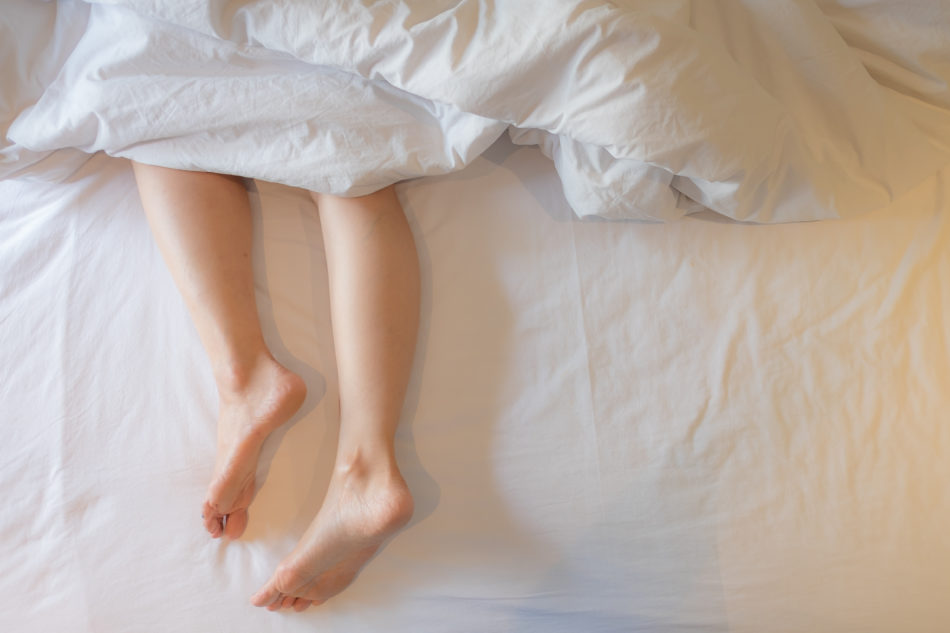
The Symptoms of RLS
Restless Leg Syndrome (RLS) is a common issue for many people. Studies have estimated that between 10-15% of the total population may be affected. 5% severely so, and the subsequent lack of sleep causes a devastating effect on mental and physical health and life expectancy.
Often, these patients complain of an uncontrollable urge to move their legs, usually because of an uncomfortable sensation. It typically happens in the evening or nighttime hours when sitting or lying down. Moving eases the unpleasant feeling temporarily. Many describe the feeling as “ants are crawling through my legs,” or “soda running through my veins.”
Diagnosis is based on the type and severity of symptoms and there is no blood test or imaging study that can be used to diagnose RLS. Treatment is usually aimed at relieving the symptoms and improving sleep. Typically, doctors prescribe medications that mask these symptoms. These have varying success rates usually related to the severity of the symptoms. Those with milder symptoms typically get better relief, but the medication can create unwanted side effects and even the threat of addiction.
What Causes RLS?
So, what causes Restless Leg Syndrome? For several years, Dr. Anderson and I, along with several other doctors from the Association of Extremity Nerve Surgeons (AENS) have been treating patients for pain and numbness due to neuropathy caused by pinched or compressed nerves in the legs.
Often the treatment involves surgical decompression of the nerves which is similar to carpal tunnel release. In addition to pain, burning, and numbness, these patients will often also complain of the restless leg symptoms described above, and difficulty sitting or sleeping. Patients with more severe symptoms are desperate for relief, as it creates exhaustion and strains work and interpersonal relationships, and well-being.
We almost universally see dramatic post-operative improvements in the RLS symptoms along with improvements in the pain, burning, and numbness from the neuropathy. We began to wonder what the potential link between nerve entrapment and RLS could be. That’s what inspired us to begin doing research. Dr. Anderson has published one scientific study already. There are other upcoming studies that provide consistent data to show that RLS can be reversed with decompression techniques.
15 Years of Suffering From RLS
Today, I want to tell you about one particular patient case. In this case, we see how RLS symptoms can be significantly improved by nerve decompression surgery, and how to test this prior to surgery to see if this type of surgery will help.
This patient is a 52 year-old female with a 15 + year history of RLS. She had significant issues with sleep and had been treating this with drug therapy, Iron supplements, vitamins, and diet changes with no improvements.
For about a year prior to her first visit with me, she had been wearing an activity monitor to track her sleep. She quickly realized that on most nights she was showing signs of significant movement every 20-30 minutes. She didn’t always fully wake up but was concerned that her poor sleep quality was becoming a problem.
Is It A Pinched Nerve?
One technique that is very helpful to test if pinched nerves are causing the symptoms is to perform diagnostic nerve blocks at the affected nerves. This simply involves injecting a small amount of cortisone and local anesthetic next to the nerves. If the nerves are chronically pinched and damaged, then the injection will temporarily calm them down.
Most often these patients will have 5-7 days of relief of their symptoms after the injections. If so, then it is likely that nerve decompression surgery will help that patient. If the injections do not provide relief, then the surgery will not likely help.
Today, Her Symptoms Are Gone
For this patient, the injections gave her quite a bit of relief for about 2 weeks. Once the symptoms started to return, she was ready to schedule the surgeries. I do not typically operate on both legs at once so I performed surgery on her right leg first, then her left leg 3 weeks later.
Her symptoms resolved quickly and she has not had any return of RLS in 6 months after surgery.
This type of surgery is very successful for 85-90% of RLS sufferers who are appropriate candidates. They can often return to their lives with little to no symptoms.
If you or someone you love has been suffering from RLS, please come see us. We have treated hundreds of patients successfully, and we would love to help you get your life back.
Learn about more treatment options for RLS.
To make an appointment, click here.
Winning the Jules Tinel Award: My Journey
The Patient Who Started It All
14 years ago, I made a bold decision to do something conventional medicine wasn’t doing. Little did I know it would change my professional life forever. Back then, I never thought that one day I would work to reverse the symptoms of neuropathy (the burning, tingling, numbness and pain many diabetic and non-diabetics suffer with).
That all changed one day when I met this patient. He was diabetic, and hadn’t felt the bottom of his feet in 20 years. I was training under a John Hopkins plastic surgeon, Dr. Lee Dellon, and he had performed surgery on the patient four days earlier. Now here he was for his follow-up appointment. The surgeon stroked the bottom of the patient’s foot, and this man who came in so stoic began to laugh like a child and then the tears started flowing down his face. That moment started my journey. I knew right then and there that I wanted to prove to the medical world that the symptoms of neuropathy could be reversed, and that patients didn’t have to suffer and live on medication.
How the Research Started
It was a slow process to adopt Dr. Dellon’s ideas into my practice. Soon after my training, I helped form an organization with other colleagues called the Association of Extremity Surgeons. In this process, my passion grew for what I was doing and how it was transforming people’s lives. The drive to do research came to me out of frustration. I was frustrated because I wanted patients and doctors to know neuropathy can be reversible, and I had to prove it.
Gradually, research became a part of the practice. I was warned that research is very hard, and I soon discovered that it was. I had to form a team to support the vision. The process to do this started several years ago and the research continued to grow.
Research On Diabetic Neuropathy
Too many people are suffering from the symptoms of neuropathy, and too many diabetics have amputations and are at risk of dying because of the loss of their limbs. Because of this belief, we completed a study on intraoperative nerve monitoring in diabetics with severe neuropathy. No one had ever recorded and published a paper to prove that nerve function can rapidly be improved when tight nerve tunnels in diabetics are opened (decompressed).
The study objectively proves what I watched the patient I mentioned earlier experience. Our testing shows that the nerve function improves up to 300 percent within minutes during surgery. And this defies the conventional medicine approach. This study was ground breaking, and my hope is that along with other studies that have been and will be published, the thoughts of the medical world and the public will begin to shift.
Winning The Jules Tinel Award
Recently, I attended the annual meeting for the Association of Extremity Nerve Surgeons. This organization includes: podiatrists, plastic surgeons, neurosurgeons and orthopedic surgeons who all share a common goal of reversing nerve pain in the extremities. At the meeting, I was honored to receive the Jules Tinel award for the scientific advancement of knowledge regarding the human peripheral nervous system. Other doctors to have received this award are: Dr. Lee Dellon from John Hopkins who introduced the concept of nerve decompression for neuropathy, Dr. Maria Seminow from the Cleveland Clinic, the first American doctor to do a face transplant, and Dr. Ivan Ducic of Georgetown Medical School, the first doctor to surgically reverse severe headaches.
We all appreciate recognition, but it’s very special when it’s coming from your peers. I’m grateful to have received this award, and grateful for all the support given to me by my colleagues and the team that helps me, and my wife who has always understood and supported me.
And I’m especially grateful to all the patients who have trusted in me and taught me to be grateful for the ability to offer hope where there once was none.
——————————————————————————————
To learn more about neuropathy, and how we treat it, click here.
To make an appointment, click here.
Zelda’s Story: RLS Non-Surgical Treatment
No Solution for RLS?
Zelda had struggled with Restless Leg Syndrome (RLS) for years. The constant need to move her legs and creepy-crawly sensation was keeping her awake at night and affecting her daily activities. “I went to different doctors,” Zelda says, “But they told me there was nothing they could do.”
When You Can’t Sit Still
Zelda’s RLS symptoms didn’t just flare up at night, she was having a hard time getting through her daily activities as well.
“I couldn’t go to church anymore. I couldn’t go to a movie, or sit down to crotchet or even eat a meal.” Zelda says. She tried taking a medicine called Tramadol, but most of the time, it didn’t help. She eventually tried spraying Icy Hot on her legs just to dull the pain.
Finally, An Answer Online
The constant need to get up and pace was taking a toll on Zelda. “I couldn’t stay still, and I couldn’t get any relief,” she says.
Finally, one day, her daughter got online to look for answers, found Dr. James Anderson, DPM, and made an appointment.
RLS Non-Surgical Treatment
Zelda met with the Dr. Anderson, and he recommended a combination of ESTIM and MLS laser treatment. Dr. Anderson says, “This was a great option for Zelda because she was able to avoid surgery, and get the relief that she was looking for.”
ESTIM is an electrical stimulation treatment. “We use this to send various pulse waves into the leg, and it can stimulate the nerves to want to repair themselves,” Dr. Anderson explains.
The MLS laser works more on the cellular level. Dr. Anderson says, “The mitochondria is the “energy-creating” part of your cells. The laser works by targeting the mitochondria specifically in the nerve cells to help repair the damaged nerve tissue.”
All the Difference
For Zelda, this treatment made all the difference. Before she even finished her treatment, she was reporting 90-95% improvement in her symptoms.
“Now, I can sit. I can eat, and I don’t have any pain. I’m sleeping through the night, and the jittery feeling is gone,” she says. Zelda is back to the activities she loves. She can crotchet, go to the movies, and go to church. Her advice for others experiencing RLS symptoms is this.
“Just make an appointment because there is no one else out there doing this. Even if it only helps 75%, it’s worth it. To be able to sleep, and live your daily life again, it makes all the difference in the world.”
————————————————————————————————–
Learn about more treatment options for RLS.
To make an appointment, click here.
Peripheral Neuropathy: Don’t Just “Live With It”
Peripheral neuropathy is a very common issue that affects patient’s legs and feet. Yet for something so common, we have a long way to go to help manage this painful and potentially debilitating problem. For most people, the symptoms start slowly and gradually worsen over time.
This slow onset can delay the onset of diagnosis and treatment for months, or even years. The symptoms are often different from person to person making it difficult for a doctor to easily recognize the problem early. Furthermore, there are multiple potential causes for the chronic nerve damage and multiple potential treatments depending on the cause. Long story short…peripheral neuropathy can be a tough row to hoe. But, there is good news.
Only Two Choices?
Too often in my experience, patients with peripheral neuropathy hear that they have only two choices:
1) Take pain medications to mask the symptoms
2) Live with it until the nerves die off and no longer cause pain
For years, doctors have searched for other options that would relieve or cure the symptoms regardless of the cause or severity of the nerve damage. They have tried many treatments, medications, and therapies that have only lead to disappointment. But, there is good news.
The Good News: ESTIM Treatment
Now, here’s the good part. Recently, one treatment (often referred to as ESTIM therapy) has shown quite a lot of promise in relieving, and even eliminating the pain from peripheral neuropathy. A company called NEUROGENX developed this therapy.
ESTIM combines a commonly used local anesthetic with a new type of electrical signals generated by a computer. Together, they can gradually heal nerve tissue by addressing the primary underlying cause of most nerve damage, lack of blood flow and oxygen to the nerves. Over the last four years, we have been using the NEUROGENX ESTIM treatment at our clinics to help patients suffering with different types of neuropathy. And we have seen dramatic results, especially when compared to other available treatments.
How ESTIM Works
For patients with peripheral neuropathy, limited blood flow and oxygen delivery can cause slow nerve healing. Whatever is causing damage to the nerve also can damage the small blood vessels that feed the nerve.
The ESTIM treatment combines both electrical and chemical treatment to stimulate increased blood flow and increased nerve healing. The injections use a local anesthetic called “marcaine” which opens and dilates the blood vessels feeding the nerves. Once the blood vessels are open, the electrical impulse goes through the nerve to “jump start” it and stimulate healing. The computer generates an electric signal that changes constantly. This means that the nerve does not “get used to” the signal, which would reduce the effectiveness.
So with each ESTIM treatment, the nerve receives both the nutrients it needs and the electrical signals telling it what to do. With this, the nerve is able to repair and heal the damage. With each subsequent treatment, more and more damaged nerve tissue repairs itself.
The Patient Experience
The most important thing to us is that we see patients have a dramatic improvement in their quality of life. When they come back to see us and report 85, 95, and sometimes even 100% improvement, that is the most rewarding part of what we do as doctors. I would like to end this blog with a quote from a patient named Zelda.
“Now after treatment, I can walk again. I’m back to my normal activities, and I don’t have any pain. I’m sleeping through the night, and the jittery feeling in my legs is gone. Just make an appointment because there is no one else out there doing this. Even if it only helps 75%, it’s worth it. To be able to live your daily life again, it makes all the difference in the world.”
If you would like to learn more about ESTIM treatment, please call us and make an appointment. We would be happy to answer your questions or schedule an evaluation to see if this therapy is right for you.
Come see us, we can help. To learn more about how we treat neuropathy, click here.
To make an appointment, click here.
Shelly’s Story: Searching for an “RLS Cure” at 2:30am

Shelly was no stranger to 2:30am. Like many people who struggle with Restless Leg Syndrome (RLS), she was used to being awake while the rest of the world was asleep. Finally one night, she had enough. She went online, typed in “RLS cure” and began searching for a solution. What she found would change her life.
When You Just Have to Move
Shelly had been suffering from RLS for years. As a teacher, she was struggling with being exhausted all the time. “It seemed like I never got a full night of sleep, or settled into that deep “REM” sleep. I was continuously being interrupted by my legs tingling, twitching, and jerking. It felt like I just had to get up and move around no matter what I tried,” Shelly says.
When Medication Isn’t Enough
“The symptoms would start around 7:00pm every night. And it just got worse from there. Eventually, I started experiencing the symptoms earlier and earlier in the day. I just couldn’t figure it out,” Shelly says. “If I walked too much, if I didn’t walk enough…I just couldn’t ever find a pattern of movement that would give me relief.”
Shelly went to her PCP, and began trying medication after medication. “Over the counter meds didn’t even touch it. One medication kept me up all night, another one totally changed my personality. I was just out of it all the time,” Shelly remembers. “I really, really wanted to get off the medication and was hoping to find a doctor that would support that.”
The Breaking Point
For most people, there comes a point when you realize just how bad it is. For Shelly, that came on a car ride.
“My son was playing football, and we had to travel about two hours away from home to watch his games,” Shelly remembers. “I could barely make it down there. We constantly had to stop the car so I could get out and move. And it just hit me. I couldn’t go to the movies. I couldn’t sit in the car. As soon as I sat down, I had to get up and move. I was constantly frustrated, and I just wasn’t enjoying the little things in life anymore.”
Searching for an “RLS Cure” at 2:30am
Finally, one night Shelly began searching online and she found a story that got her attention. She read about a woman named Bonnie who had nerve decompression surgery and finally was able to sleep after 20+ years of suffering from RLS. Shelly remembers reading through to the end of her story and being in tears. “I thought, ok, this is it. This is what I’m doing,” she says.
From Michigan to Colorado
Shelly lives in Michigan and was ready to make the trip to Colorado for treatment. She called and spoke with Dr. James Anderson, DPM, over the phone and felt confident in her decision.
“He answered all my questions, and supported my desire to get off medication,” Shelly says. “That was a big deal to me.”
Shelly traveled to Fort Collins, CO, and had nerve decompression surgery on one leg first to make sure she would get the results she was hoping for. And she did.
Dr. Anderson says, “Because Shelly traveled for treatment and she had a great immediate result on the first leg, we felt confident that this was going to be the right approach for her. Ultimately, the goal is to resolve her RLS symptoms. The surgery takes about an hour, and we go in to open up nerve tunnels that have become compressed in the leg and cause these symptoms.”
Within days, Shelly had surgery on the second leg. “I felt a huge difference immediately,” she says.

Life Today
Shelly traveled back home to Michigan, and she slept all night long. “My husband said my legs were so still, he wanted to poke me to make sure I was still alive,” Shelly says, laughing.
“Within a week, I felt like I was back to being myself. I’m finally getting that deep sleep I need. My memory is better. I’m alert. I’m rested. My family just couldn’t believe how immediate the change was.”
“I’m happy to report that I can now go to my son’s football games and sit, and enjoy every minute of it.”
Shelly’s advice for others is this.”If you are struggling with RLS and it is affecting your quality of sleep and day-to-day activities, please consider giving Dr. Anderson and his staff a call. They will be very helpful in answering any questions that you might have. I am truly amazed by how this surgery has helped me. My symptoms are virtually gone. I wish I would have done this years ago!”
————————————————————————————————–
Summer Special!
Now offering a FREE new patient exam and consultation! Expires 6/30/18. *X-Rays, testing and treatment not included.
Call us today! Just mention this blog to receive the offer.
To watch Shelly share her story, click here.
Neuropathy 101: Part 3 (Real Patients, Real Stories)
Welcome to Part 3 of our blog, Neuropathy 101. We’ve discussed the signs and symptoms in Part 1, and advanced treatment options in Part 2.
And, of course, we saved the best part for last. If you or someone you love is suffering from neuropathy, the most important thing for you to know is that there is hope. You don’t have to suffer and let neuropathy take over your life.
Today, I want to share with you the stories of three patients who came to see us with different symptoms, frustrations and needs. And after treatment, they are all experiencing the improved quality of life they were hoping for. After practicing for more than 35 years, there is still nothing more rewarding to me than hearing patients come in and tell me how their life has changed for the better since treatment. Here are their stories.
Evelyn’s Story
Symptoms:
“When I came to see Dr. Anderson, I had so much numbness in my feet and it was so painful. My feet hurt so bad by the end of the day, I wasn’t able to wear shoes. I was ready to go stark raving mad. I could only wear sandals and I live in Wyoming. And in the winter, I will tell you I definitely did not want to be wearing sandals,” Evelyn says.
Treatment:
Evelyn had nerve decompression surgery on both legs. This is a 1-hour procedure where we go in surgically to open up the nerves that become compressed in the legs, and cause severe neuropathy symptoms.
Life Today:
Today, Evelyn says, “I have new shoes that I got a year ago and I can finally wear them all day. It was so funny because my husband thought I had gone shopping and bought all new shoes. But, I was just finally able to wear all my own shoes again! At night when I got to bed, I can actually feel the covers with my toes, which I haven’t been able to do in years. I have no pain. I can be so much more active now. I’m ready to go dancing! If you are having problems with your feet, come see him and get the help you need!”
John’s Story
Symptoms:
“Most of my symptoms were occurring on the bottom of my feet. I was having a hard time being active because it took me so long to recover. If I walked about a mile, the balls of my feet would be so sore, it would take a full day just for me to start feeling better,” John says.
Treatment:
John had the ESTIM & MLS Laser treatment we discussed in Part 2 of this blog. Because John’s symptoms were not as severe, our non-surgical treatment options were a good fit for him. The ESTIM treatment is an electrical stimulation therapy, and the laser treatment works on the cellular level. Both treatments work in harmony together to help repair and restore the damaged nerves.
Life Today:
Before he was finished with treatment, John was already reporting significant symptom improvement. “I would say I’m 70-80% better already, and that’s being conservative. I can now walk 2 miles a day, and my feet recover in about an hour. I’m very happy with my results,” John says.
Kelly’s Story
Symptoms:
“I was experiencing a lot of numbness in my feet and struggling with loss of balance. By the end of the day, I was just in excruciating pain. I am on my feet all day at work, and I tried every type of shoe and insole out there, and nothing worked. I don’t really like to take pills, so I didn’t want to get on medication for it, but I really was searching for relief,” Kelly says.
Treatment:
Kelly had nerve decompression surgery on both legs, just like our first patient Evelyn did. This is a great option for many people with severe neuropathy and pain because it’s a minimally-invasive procedure and there is very little down time. Most patients can be up and walking around the day after surgery.
Life Today:
“I don’t dread getting up in the morning anymore. Now I can get through work every day. My heel pain has resolved as well, and my balance is so much better. I feel confident in where I’m stepping and I have that “front to back” feeling of motion that I didn’t have before. I would do the surgery again, in a heartbeat,” Kelly says.
Don’t Give Up
Every day I see patients who come in and they are experiencing incredible results like these. They are back to work, to play and to the activities they love. My desire for you who are reading this is that you would be encouraged to not give up.
Come see us, we can help. To learn more about how we treat neuropathy, click here.
To make an appointment, click here.
Neuropathy 101: Part 2 (Treatment Options)
In Part 1 of this blog series, we talked about the symptoms, locations and causes of neuropathy. Today, we will discuss the treatment options available. First, I would like to address the approach that many patients experience with conventional medicine. Next, we will talk specifically about our approach, and the treatment options we use that have shown to have a high success rate in patients suffering from neuropathy. Let’s jump in.
The Pharmaceutical Approach
In conventional medicine today, it has become very commonplace to treat neuropathy with medication. I call this the pharmaceutical approach. Medications that are typically prescribed can include Lyrica, Neurontin and Gabapentin.
While these can have some positive impact, the side effects are often what patients struggle with. They can start to feel spacey, and also gain weight. Although the average weight gain is between 10-15 pounds, I have seen some patients gain as much as 40-60 pounds taking these medications. In severe cases, sometimes patients resort to taking narcotics for pain relief, and then there is the risk of opiate addiction.
Is it Coming From Your Back?
The second approach I typically see is that patients have heard the primary cause of their symptoms is coming from their back. They come to us and are often confused. They say, “I went to one doctor and they said my nerves are diseased, and then I went to another doctor and they said it’s coming from my back.”
Many times these patients have been told all they can do is live with it or take medication. If they have been told it’s coming from their back, they might look into chiropractic care, physical therapy, injections, or even surgery.
Our Approach
Our approach is different. We look at the lower limb much like you would look at the upper limb. There are nerve tunnels in the lower extremity that can become compressed or damaged. And the good news is that this gives us the opportunity to reverse the symptoms of neuropathy. Depending on the patient’s exam results and symptoms, we have both surgical and non-surgical treatment options available.
Nerve Decompression Surgery
This is a minimally-invasive, 1-hour procedure. We go in surgically to open up nerve tunnels in the patient’s leg that have become compressed. When we release the pressure from the nerve, patients often see up to 90% improvement from their symptoms. Whether they have diabetic neuropathy, non-diabetic neuropathy, or even chemo-induced neuropathy, we typically see a high success rate with this treatment option. This is also most appropriate for patients with very severe neuropathy symptoms.
ESTIM Treatment
This is a non-surgical treatment option. ESTIM is an electrical stimulation treatment. We use this on the nerves, and send various pulse waves into the anatomy of the leg. This can stimulate the nerves to want to repair themselves. Studies have shown increased nerve repair, and demonstrated how small nerve endings come back to life after ESTIM treatment.
MLS Laser Treatment
This is also a non-surgical treatment option, and it works more on the cellular level. The mitochondria is the “energy-creating” part of your cells. The laser works by targeting the mitochondria specifically in the nerve cells to help repair the damaged nerve tissue.We often use ESTIM and MLS Laser treatment in combination because it can be very effective in providing relief to a patient suffering from nerve pain.
My goal in sharing these treatment options with you is ultimately to instill hope. I find that most patients suffering from severe neuropathy struggle to keep hope alive.
We see patients every day who are finding relief from their neuropathy and nerve pain after years of suffering. In Part 3 of this blog, I will share some of these patient success stories with you. Stay tuned! You don’t want to miss it.
To learn more about how we treat neuropathy, click here .
Part three of this blog post can be viewed at ‘Real Patient Real Stores‘.
To make an appointment, click here.
